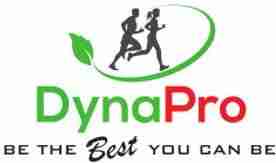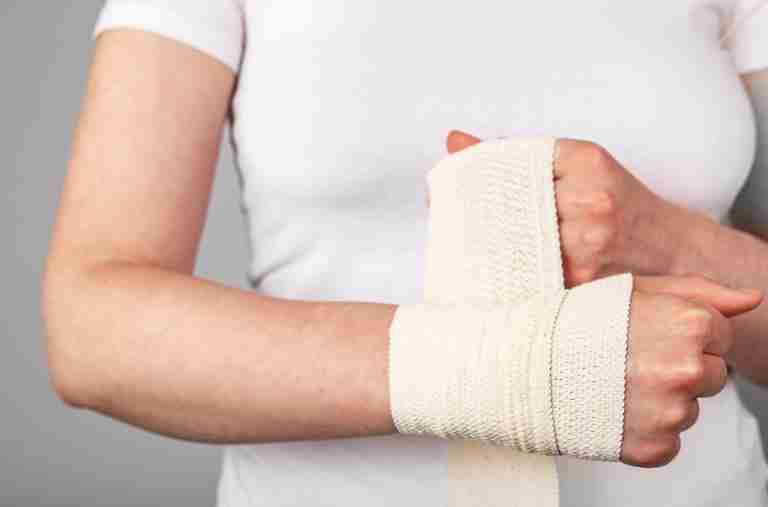Cohesive Tape vs Athletic Tape: 5 Important Differences
In this article, we explain 5 significant differences of cohesive tape vs athletic tape as used in sports medicine. We will then go on to explain how these differences lead to differences in how these two types of tape are used in sports medicine.
Cohesive tape has grown significantly in popularity during the past few years and has the distinguishing feature of adhering only to itself. It comes in various colours and sizes but in general, the most popular choices are 2″ and 3″ widths and black and white colours. A good example of this type of tape is the DynaPro SellfWrap Bandage.
Athletic tape can have various meanings depending on the context in which the term occurs. In this article, we will assume that the term refers to adhesive cotton tape with a zinc oxide based adhesive. This type of tape is most commonly purchased with a 1.5 inch width and in colour white. A good example of this type of tape is the DynaPro Porous Zinc Oxide Tape.
Cohesive Tape vs Athletic Tape: 5 Significant Differences
We will now proceed to explore 5 differences between these types of tape in the context of their usage in sports medicine.
- Material Composition: The first important difference between cohesive tape and zinc oxide athletic tape lies in their material composition. Cohesive tape is primarily made of self-adhesive elastic material, which does not stick to the skin or hair but strongly adheres to itself when wrapped around the body. On the other hand, zinc oxide athletic tape is made of woven cotton fabric with a zinc oxide adhesive coating, providing a strong and adhesive grip.
- Adhesive Properties: Another crucial distinction between the two tapes is their adhesive properties. Cohesive tape, as mentioned earlier, adheres only to itself, allowing for secure wrapping without leaving any sticky residue on the skin. This characteristic makes it ideal for providing compression and support without causing discomfort during removal. In contrast, zinc oxide athletic tape has a strong adhesive quality that sticks directly to the skin, ensuring firm immobilization and stability of joints or muscles.
- Stretchability: Cohesive tape is known for its excellent stretchability, which allows it to conform to body contours and provide an optimal fit. It can expand and contract with body movement, providing flexibility without compromising support. On the contrary, zinc oxide athletic tape has limited stretchability due to its woven cotton fabric composition. While it provides a rigid support that restricts movement, it may not conform as well to body parts with complex shapes.
- Breathability: When it comes to breathability, cohesive tape offers better ventilation compared to zinc oxide athletic tape. The self-adhesive elastic material of cohesive tape allows air circulation through the tape, preventing excessive heat buildup and moisture accumulation. This quality makes it suitable for prolonged use, especially in sports activities where perspiration is common. Zinc oxide athletic tape, however, has a less breathable nature due to its fabric composition, which can lead to increased perspiration and discomfort during extended periods of wear.
- Applications: Lastly, one of the main distinctions between the two tapes lies in their specific applications in sports medicine. Cohesive tape is commonly used for compression and support in wrapping joints, securing dressings, or providing light immobilization for minor injuries. Its self-adhesive nature and stretchability make it versatile in various sports-related situations. Zinc oxide athletic tape, on the other hand, is primarily used for rigid immobilization, frequently employed in strapping ankles, wrists, or other body parts requiring more stability during intense physical activities.
In summary, when comparing cohesive tape vs athletic tape, there are important differences in the areas of material composition, adhesive properties, stretchability, breathability, and specific applications in sports medicine.
These variances make them suitable for different purposes, allowing sports medicine professionals to choose the most appropriate tape based on individual needs and injury requirements. We will explore these differences in application in greater detail below.
Cohesive Tape vs Athletic Tape: Differences In Sports Medicine Usage

The dissimilarities between the properties of cohesive tape vs athletic tape give rise to variations in their applications within the field of sports medicine.
Cohesive tape, often referred to as self-adhesive or self-stick tape, possesses the unique characteristic of sticking only to itself. This feature allows cohesive tape to provide effective support and compression without the need for additional adhesives or fasteners. On the other hand, zinc oxide athletic tape contains a zinc oxide-based adhesive that firmly adheres to the skin and provides enhanced stability and immobilization to injured areas.
Due to its self-adherent nature, cohesive tape is particularly advantageous in situations where frequent adjustments or readjustments are required. It is commonly utilized for creating secure bandages, holding dressings in place, and supporting joints or muscles without restricting movement. The ease of application and removal makes cohesive tape an ideal choice for athletes who may need to continuously modify their taping during training or competition. Moreover, its ability to adhere to itself allows for a consistent level of support throughout various movements, making it preferred for dynamic activities or sports.
Zinc oxide athletic tape, on the contrary, is favoured for its strong adhesive properties, which ensure long-lasting and secure taping. The firm adherence of zinc oxide tape makes it suitable for stabilizing joints, immobilizing fractures, and protecting areas susceptible to injury. Its rigid structure provides excellent support, restricts excessive joint movement, and reduces the risk of further damage. This type of tape is frequently used in sports medicine to address more severe injuries or conditions that demand immobilization or strict stability, such as sprained ankles or fractured bones.
Another important difference between the applications of these two types of tape is the ability to use cohesive tape for treating animals like horses or dogs. The self adhesive nature of cohesive tape allows it to be used on these animals with less risk of tearing skin or fur (with consequent distress to the animal) when the tape is removed. The adhesive nature of zinc oxide adhesive tape does not allow for this type of use.
For more information on the applications of zinc oxide athletic tape, we suggest reading this post.
In summary, the diverging characteristics of cohesive tape and zinc oxide athletic tape play a key role in their specific applications in sports medicine. The self adherent property of cohesive tape enables flexibility, ease of adjustment, and consistent support, making it ideal for dynamic activities. Conversely, the strong adhesive properties of inc oxide athletic tape offers long-lasting stability and immobilization, making it suitable for more severe injuries where rigid support and/or near immobilization may be necessary. Understanding these disparities assists sports medicine practitioners in choosing the appropriate tape for each situation, ensuring optimal treatment and support for athletes.
Conclusion
In this post, we have explored the properties of cohesive tape vs athletic tape. We have also explained how these differences result in different uses for these 2 types of tape in sports medicine.
If you have any questions or comments on the information included in this article, please leave them in the space provided below.








Exciting read! Understanding the differences between cohesive and athletic tape is essential. Looking forward to diving into the article.